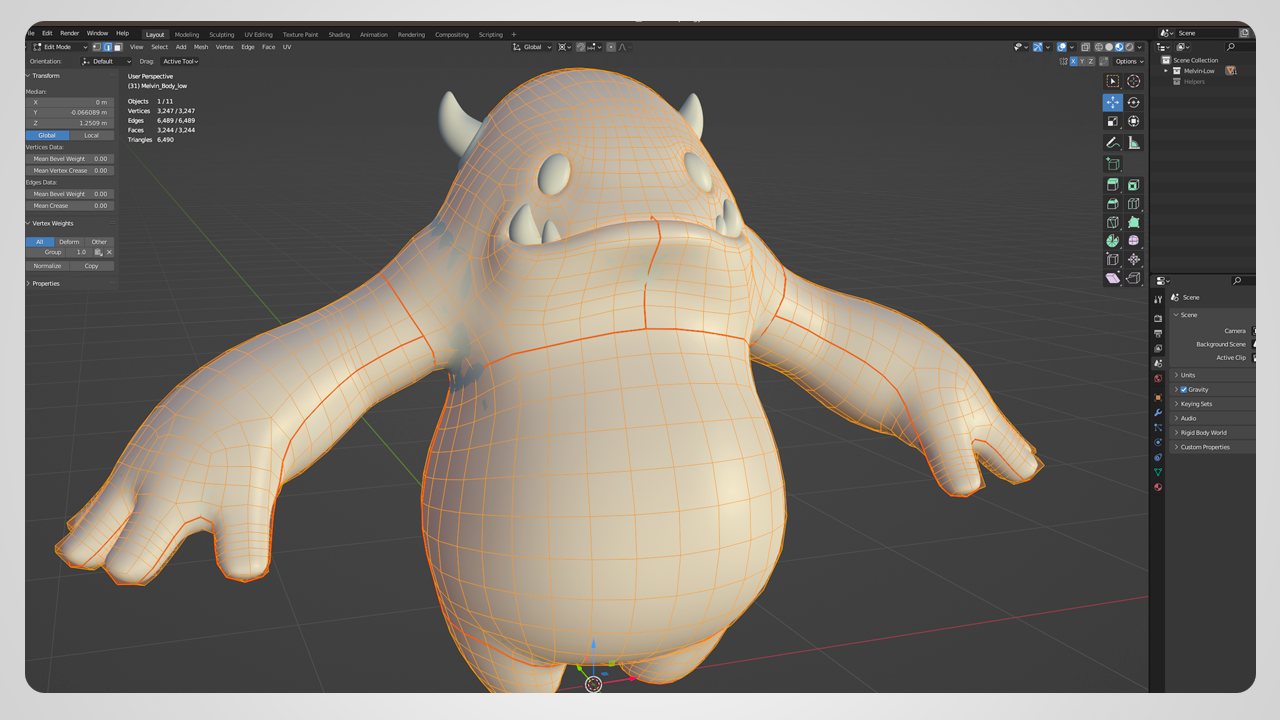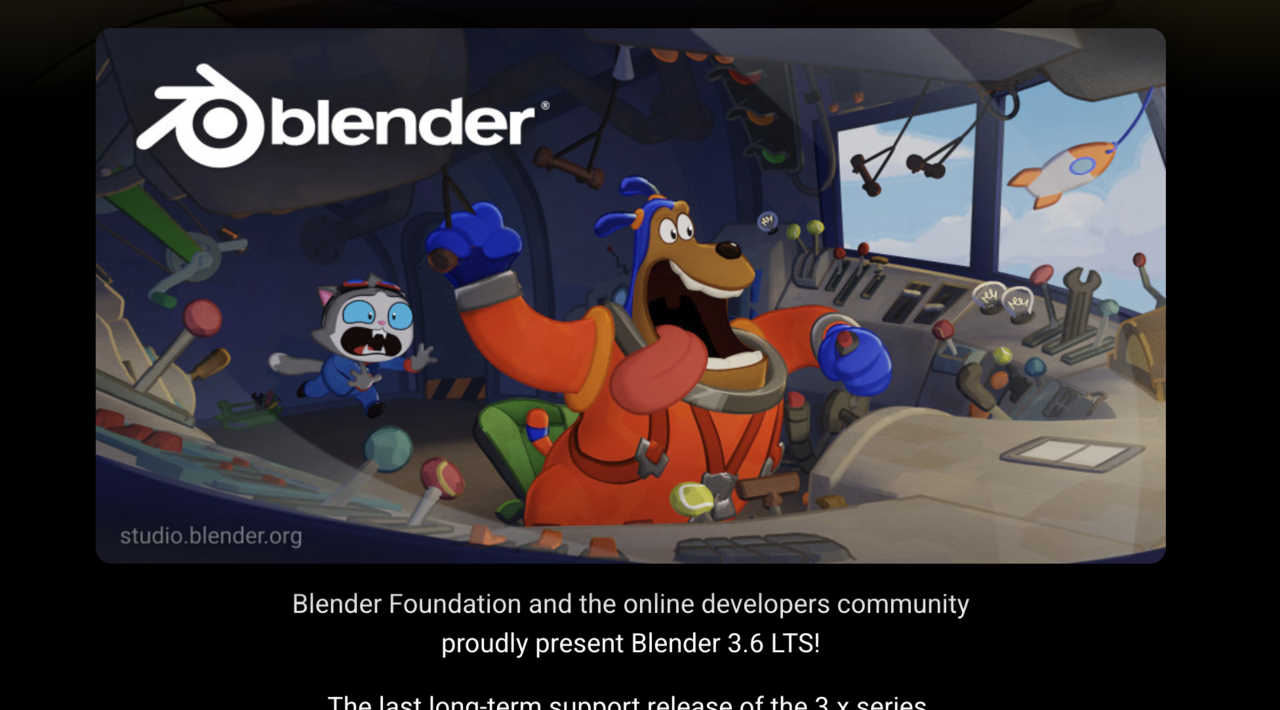
- What is Blender 3D?
- Understanding Blender's release schedule.
- What is Blender LTS?
- When is Blender 4.0 expected to be released?
- How to contribute to the development of Blender.
- How to update Blender?
What is Blender?
Blender is a free, open-source 3D creation software that is widely used by CG artists, and developers to create stunning 3D animations, visual effects, and 3D models.
Since its first open-source release in October of 2002, Blender has become one of the most popular tools of choice for 3D artists around the world, downloaded more than 16 million times a year according to the 2021 Blender annual report.

Blender has an incredible number of features built-in which make it a jack of all trades and a master of one or two. Here are a few things you’re able to do with Blender.
- Modeling: Creating essential 3d models and characters for your animated short film, 3D printer, and or VR immersive experience.
- 2D in 3D: A tool inside Blender called Grease Pencil enables traditional art and animation workflows in a 3D environment.
- Animation: From animating a simple object in Blender to more complex animation topics like character movement, users can bring their 3D models to life in Blender.
- Texturing: With using photos, procedural textures, or hand-painted textures to add life and color to your 3D models and animation.
- Rendering: Convert your 3D scene into an image or movie to share online with others.
Blender is available on all major operating systems, including Windows, macOS, and Linux, making it a versatile tool for a wide range of users. Read more about various hardware requirements.
- Read about Blender's story.
- Stream the Blender Basics tutorial course,
- Where and how to download Blender.
Understanding Blender's release schedule
Blender release cycles have fluctuated a lot over the course of its life. It started on a "release when it's done" model with an emphasis on "release early, release often" to ensure that users could test new features as soon as possible.
Needing a little structure to this, they then tried for a release ever two months. However, that pace was quite breakneck, so they attempted to slow down and do 1-2 releases a year across the development of 2.5 (and I think until 2.8).
Unfortunately, while those slow cycles were more predictable, it didn't offer much opportunity for testing since users tended to only try out newly released versions rather than betas. New features sat in the wings waiting for development energy to finish.
That brings us to the release schedule that we've had up until now with LTS releases and overlapping development cycles. And this new schedule is a tweak on that.
Recently the Blender Foundation announced an update to the Blender release cycle. Most notably reducing the planned releases to three a year, and gave us a glimpse of when to expect the next version of

The new schedule extends development periods Bcon1 and Bcon2 to better align with annual events such as SIGGRAPH and Blender Conference. It also slates Blender 3.6 as the next LTS version, expected to be released this July, with support through July 2025.
To stay on top of the Blender release schedule and development updates check https://code.blender.org/. Additionally, the team there offers weekly blog updates you may subscribe to.
What is Blender LTS?
If you’re looking for a stable and consistent version of Blender for your work in education or production, Blender LTS is an important version of Blender for you to be aware of.
Blender LTS stands for Long Term Support. It’s a specific version of Blender that is supported with updates, bug fixes, and security updates for two years after its initial release. This helps mitigate compatibility issues with users working on long-term projects and ensures your workflow stays functional and secure.
The current Blender 3.6. LTS can be downloaded here and the release notes can be reviewed here.

There you can view the change log and download the various platform versions of LTS. You may also have Blender auto-magically updated if you download and install Blender through Steam, Microsoft Store, or Snapcraft.
For educators and production studios, we recommend sticking to the LTS releases, with the next LTS version expected to be Blender 3.6.
When is the expected release date of Blender 4.0?
Update: it's been released as of November 14th! https://cgcookie.com/posts/everything-new-in-blender-4-0
Anticipation is growing for the next major version release of Blender. Following the Blender Foundation’s recent update, Blender users can expect Blender 4.0 to be released on November 14th 2023.

Stay on top of release notes by visiting the Blende Wiki’s release notes page.

Just announced! Grease Pencil 3.0 is targeted to be included in the Blender 4.0 release.
Additionally, we’ll keep this page updated as release notes become available. Bookmark this page!
How can users provide feedback or contribute to the development of Blender?
As open-source software anyone can contribute to Blender’s development, reporting bugs or proposing new features. To get involved visit https://projects.blender.org to report bugs to make Blender more stable or join the Blender developer community.

For non-developers, one of the most valuable contributions you can make is to Blender’s documentation. If you’ve ever looked through the Blender user manual and found a typo or thought something was missing, you can be the one who fixes that!
How to update Blender?
It's not uncommon for Blender users to retain multiple versions of Blender on their local machines. Either to help follow along on tutorials, preferences for running the Blender LTS version mentioned above, or playing with new experimental builds.

With no auto-update feature built into Blender, the majority of users download the latest version of the Blender software from http://blender.org/download directly. By choosing their operating system and downloading it to their local machine.
If you're interested in the LTS (Long Term Supported) version of Blender, this is done directly by visiting https://www.blender.org/download/lts/ with the current version of Blender 3.3LTS to be supported through September 2024.
Those hungry for daily builds of Blender to test new features and cool bug fixes have access to fresh versions of Blender daily to be downloaded from https://builder.blender.org/download/daily/
It should be mentioned there are two platforms that will help with auto-updating of Blender if you've installed Blender from the Steam Store or the Microsoft Store.

Wow, this article really breaks down Blender's release schedule! Super helpful for planning my projects. Good to know 3.6 is the next LTS version. Now if only there was something like DuckovGame.com for Blender - The ultimate one-stop-shop.
This is great news for Blender users! Knowing the release schedule and LTS versions helps a lot for planning projects. Especially useful if, like me, you're still struggling to figure out No i'm not a human https://iamnotahuman.org stuff in Blender! Glad CG Cookie is providing a guide.
Okay, so Blender's changing up their release schedule again! Good to know they're thinking about stability with the LTS versions, especially since I'm diving into 3D animation. This whole thing feels like stepping into The freak circus https://thefreakcircus.org of software development sometimes, lol.
Okay, so Blender's tweaking its release schedule again. Three releases a year now! Sounds less like ruling a kingdom and more like Sort The Court https://sortthecourt.org , juggling updates. Hopefully, this means less buggy features. Fingers crossed!
Okay, this article is super helpful for keeping up with Blender's updates. Knowing about the LTS releases is key for my longer projects. Wish I had more time to dive in, but always feels like a Pips game https://pipsgamenyt.org against the clock, haha!
Wow, this is super helpful for planning my Blender projects! Knowing the release schedule, especially about the LTS versions, is key. Gotta stay updated! Kinda reminds me of those Bomb It https://bombitonline.org games, always gotta be ready for the next update, haha!
Blender updates all the time! Forget logic. Forget reason. Embrace the madness! I'm always hyped for new features but also kinda scared of breaking my workflow. Throw a potato https://throwapotato.org at the old version, I guess? Let's see what Blender 4.0 brings!
Oh, that's cool! So now Blender is updating its release schedule, I think it's awesome! I'm really looking forward to the new version. It's kinda like a digital version of Spend bill gates money https://spendgatesmoney.com on a 3D masterpiece.
This is a helpful breakdown of Blender's release schedule! Good to know they're aiming for more consistency. I love finding Free star symbols https://starsymbols.io for my projects, maybe I can use Blender to create some cool 3D ones!
Hi, I see that in the Blender Release Schedule 2023-2024 is indicated that Blender is moving to version 4.0 and using the new system.
What is meant by "new system"?
I ask this because as a user of Blender for Mac OS with Intel processor I would not want this new system to refer to the release of Blender only for M1 or M2 processors.
Thank you.
Umberto